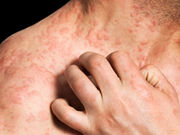Japanese man presented with itchy migrating eruption on back, which was treated with ivermectin
TUESDAY, May 23, 2017 (HealthDay News) — In a case report published online May 4 in The Journal of Dermatology, gnathostomiasis caused by ingestion of raw roe from Oncorhynchus masou ishikawae is described.
Mika Yamanaka, from the Osaka City University Graduate School of Medicine in Japan, and colleagues describe the case of a 57-year-old Japanese man who presented with an itchy migrating eruption on his back. Three weeks after catching and eating the roe of Oncorhynchus masou, he noticed right inguinal pain and erythema. An itchy erythema subsequently developed on the right abdomen and moved to the upper back.
Based on the symptoms and high eosinophil count, the researchers diagnosed the patient with gnathostomiasis. In an effort to remove the larva, skin biopsies were obtained at each end of two branches of a linear erythema on the middle back. A dense superficial and deep dermal infiltration of eosinophils were revealed on histopathological examination. Denatured collagen fragments were also observed, probably due to the larva’s transfer, without identifiable parasites. Positive results were seen in the enzyme-labeled antibody method for a serum-specific antibody against Gnathostoma spp. The patient was treated with ivermectin 200 µg/kg twice, two weeks apart; the erythema regressed and eosinophil count was reduced after treatment.
“It is well known that eating raw freshwater fish carries a high risk of infection by Gnathostoma or other parasites,” the authors write. “This study showed that freshwater fish roe may also carry Gnathostoma larvae.”
Copyright © 2017 HealthDay. All rights reserved.








